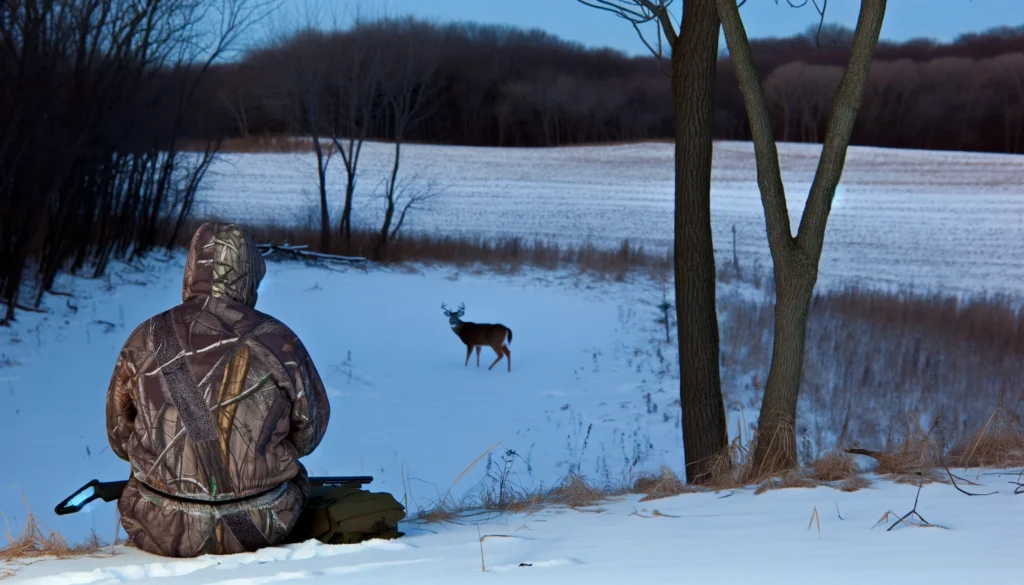The Winter Challenge: Finding & Hunting Late Season Bucks

Table of Contents
Introduction
Hunting late-season bucks presents a unique set of challenges and opportunities for the seasoned hunter. As winter tightens its grip, the landscape changes dramatically, influencing deer behavior and hunting strategies. Understanding these changes and adapting your approach can lead to successful late-season hunts. This guide delves into the strategies for finding and hunting late-season bucks, ensuring your hunting season ends as successfully as it began.
Understanding Late-Season Buck Behavior
Shift in Food Sources
With the onset of colder weather, food sources become scarce, prompting bucks to shift their feeding patterns. Focus on areas where late-season food sources are still abundant, such as agricultural fields with leftover crops, oak stands with acorns, or green plots specifically planted for winter feeding.
Bedding Area Importance
Bucks seek thick cover for bedding to shield themselves from harsh winter elements. These areas are typically on south-facing slopes that receive more sunlight or in dense conifer stands that provide better wind protection and thermal cover.
Decreased Movement
Energy conservation is crucial for survival, leading bucks to limit their movements. They will travel less and focus on short routes between bedding and feeding areas.
Late-Season Hunting Tactics
Scout for New Hotspots
Dedicate time to scouting new feeding and bedding areas. Look for fresh signs of buck activity, such as tracks, droppings, and bedding sites. Adjust your hunting spots based on your findings.
Strategic Stand Placement
Position your stands or blinds closer to the food sources and travel corridors bucks are using. Ensure you have a clear view of the area while staying downwind to avoid detection.
Patience and Persistence
Late-season hunting often requires longer wait times in colder conditions. Dress appropriately in layers and be prepared to stay out longer to catch bucks on their limited feeding forays.
Use of Calls and Decoys
Bucks may still respond to grunts or rattling, albeit less aggressively than in the rut. Use these tools sparingly to avoid spooking wary late-season bucks. Decoys can also be effective, especially near food sources or along travel corridors, to pique the curiosity of a buck.
Gear Recommendations
- Insulated Clothing: Adequate layering is key to staying warm and comfortable during long, cold waits.
- Quality Optics: With decreased daylight hours, having quality optics helps spot bucks at a distance or in low-light conditions.
- Scent Control: Late-season bucks are particularly cautious. Use scent control measures meticulously to avoid detection.
Safety Considerations
- Hypothermia Awareness: Be aware of the signs of hypothermia and take measures to stay warm and dry.
- Check Equipment: Cold weather can affect the functionality of your gear. Regularly check your equipment to ensure it’s in working order.
Conclusion
Late-season buck hunting requires adaptation, patience, and a thorough understanding of how winter affects deer behavior. By focusing on key food sources, adapting your strategies, and preparing for the cold, you can increase your chances of a late-season success. Embrace the challenge of the winter woods, and you may find late-season hunting to be among the most rewarding experiences.
Frequently Asked Questions (FAQs)
1. How do I locate late-season food sources?
Look for agricultural fields, especially those with corn or soybeans, oak stands with leftover acorns, or areas with winter food plots.
2. What’s the best time of day to hunt late-season bucks?
Focus on dawn and dusk when bucks are most likely to be feeding. However, midday hunts can also be productive, as bucks may move during warmer parts of the day.
3. How can I stay warm while hunting in cold weather?
Invest in quality insulated clothing designed for hunting, use portable heaters in blinds when safe, and keep a thermos with a warm beverage to help maintain your body temperature.
4. Are late-season bucks more cautious than earlier in the season?
Yes, after experiencing hunting pressure throughout the season, late-season bucks are typically more wary and cautious, requiring stealthier hunting tactics.
5. Can I still hunt bucks if there’s snow on the ground?
Absolutely. Snow can actually benefit hunters by making it easier to spot tracks, feeding areas, and bedding sites. Plus, it enhances visibility against the white backdrop.







